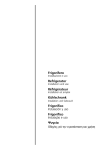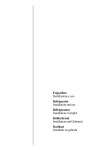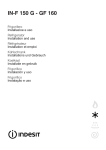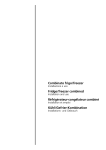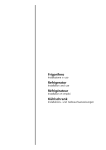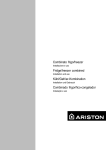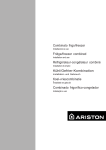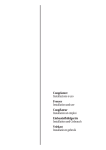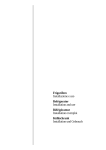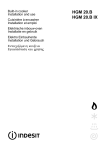Download Smeg FR138B combi-fridge
Transcript
Frigorifero
Installazione e uso
Refrigerator
Installation and use
Réfrigérateur
Installation et emploi
Kühlschrank
Installation und Gebrauch
I
Frigorifero 0 stelle
1
Istruzioni per l'installazione e l'uso
GB 0 star refrigerator
6
Instructions for installation and use
F
Réfrigérateur desous à 0 étoiles
11
Instructions pour l'installation et l'emploi
D
0-Sterne-Kühlschrank
Installation- und Gebrauchshinweise
16
La sicurezza, una buona abitudine
ATTENZIONE
Leggete attentamente le avvertenze contenute nel presente libretto in quanto forniscono importanti indicazioni riguardanti la sicurezza di installazione, d’uso e di manutenzione.
tere in bocca cubetti di ghiaccio appena estratti dal freezer
poiché rischiate di ustionarvi.
7. Non fate né pulizia né manutenzione senza aver prima
scollegato l’apparecchio dalla rete di alimentazione; non
basta, infatti, portare la manopola per la regolazione della
temperatura sulla posizione
per eliminare ogni contatto
elettrico.
8. Prima di farvi ritirare il vecchio frigorifero, mettete fuori
uso l’eventuale serratura per evitare che i bambini, giocando, possano rimanere chiusi dentro l’apparecchio.
9. In caso di guasto, prima di chiamare il servizio-assistenza,
controllate al capitolo “C’è qualche problema?” per verificare se è possibile eliminare l’eventuale inconveniente. Non
tentate di riparare il guasto, cercando di accedere alle parti
interne.
10. In caso di danneggiamento, il cavo alimentazione di
questo apparecchio deve essere sostituito obbligatoriamente dal nostro Servizio Assistenza Tecnica, essendo necessario l'uso di utensili specifici.
11. Non usate apparecchi elettrici all'interno dello scomparto
conservatore di cibi, se questi non sono del tipo raccomandato
dal costruttore.
12. Al termine della vita funzionale dell'apparecchio, contenente gas ciclopentano nella schiuma isolante ed eventualmente
gas R600a (isobutano) nel circuito refrigerante, lo stesso dovrà
essere messo in sicurezza prima dell'invio in discarica. Per questa operazione rivolgetevi al vostro negoziante o all'Ente Locale preposto.
Questa apparecchiatura è conforme alle seguenti Direttive Comunitarie:
- 73/23/CEE del 19/02/73 (Basse Tensioni) e successive
modificazioni;
- 89/336/CEE del 03/05/89 (Compatibilità Elettromagnetica)
e successive modificazioni.
1. Questo apparecchio non va installato all’aperto, nemmeno se lo spazio è riparato da una tettoia; è molto pericoloso
lasciarlo esposto alla pioggia e ai temporali.
2. Deve essere usato soltanto da adulti ed esclusivamente
per conservare e congelare i cibi, seguendo le istruzioni d’uso
scritte in questo manuale.
3. Non toccate né manovrate mai l’apparecchio a piedi nudi
o con le mani o piedi bagnati.
4. Sconsigliamo di ricorrere a prolunghe e prese multiple. Se
il frigorifero è installato tra i mobili, controllate che il cavo
non subisca piegature o compressioni pericolose.
5. Non tirate mai il cavo né il frigorifero per staccare la spina
dalla presa a muro: è molto pericoloso.
6. Non toccate le parti interne raffreddanti soprattutto con
le mani bagnate poiché potreste ustionarvi o ferirvi. Né met-
Installazione
Per garantire un buon funzionamento e un consumo
contenuto di elettricità è importante che l’installazione sia eseguita correttamente.
za degli impianti 46/90. Se manca la messa a terra, la Casa
Costruttrice declina ogni responsabilità. Non usate prese multiple o adattatori.
Posizionare l’apparecchio in mode che la presa, a cui è
collegato, sia accessibile.
L’aerazione
Il compressore ed il condensatore emettono calore e richiedono perciò una buona aerazione. Evitare di posizionare l’apparecchio in un luogo direttamente esposto alla luce solare,
accanto alla cucina elettrica o similari. Sono anche poco adatti
ambienti con una non perfetta ventilazione.
Fare attenzione, durante l’installazione, a non coprire od
ostruire le griglie che permettono la buona ventilazione dell’apparecchio.
La potenza è insufficiente?
La presa elettrica deve essere in grado di sopportare il carico
massimo di potenza dell’apparecchio, indicata sulla targhetta
caratteristiche posta in basso a sinistra accanto alla verduriera.
Prima di collegarlo elettricamente
Dopo il trasporto posizionare l’apparecchio verticalmente ed
attendere almeno 3 ore prima di collegarlo alla presa, per
consentire un corretto funzionamento.
Collegamento elettrico e messa a terra
Prima di procedere al collegamento elettrico, controllate che
il voltaggio indicato sulla targhetta caratteristiche, posta in
basso a sinistra accanto alla verduriera, corrisponda a quella
del vostro impianto di casa, e che la presa sia dotata di una
regolare messa a terra, come prescrive la legge sulla sicurez-
1
I
Visto da vicino
A
DE
Manopola per la regolazione della temperatura
Questa manopola consente di
regolare la temperatura interna del frigorifero su diverse
posizioni:
il frigo è spento;
1 freddo al minimo;
5 freddo al massimo
Potete regolare la manopola dalla posizione 1 alla posizione 5, secondo le necessità. Ricordate, inoltre, che
potete interrompere il funzionamento del frigorifero,
portando la manopola sulla posizione .
B
Cassetto per frutta e verdura
G
Ripiano copriverduriera estraibile
H
Ripiani estraibili
Evaporatore orizzontale per produzione ghiaccio
Scatola per burro, piccolo
A
B
Balconcino portaoggetti con
portauova
D
F
I
scatolame, tubetti ecc.
C
Balconcino per bottiglie
Balconcino portaoggetti
I
H
C
G
D
F
E
Come avviare il frigorifero
ATTENZIONE
Dopo il trasporto, posizionare l’apparecchio verticalmente ed attendere circa 3 ore prima di collegarlo alla
presa di corrente per favorire un buon funzionamento.
Per un funzionamento ottimale ed economico ricordatevi di porre la manopola per la regolazione della temperatura sulla posizione di temperatura media.
I
2
Prima di mettere gli alimenti nel frigorifero pulite bene l’interno con acqua tiepida e bicarbonato.
Dopo aver collegato la spina alla presa di corrente accertarvi
che la lampada di illuminazione sia accesa quindi ruotare la
manopola per la regolazione della temperatura “A” sulla
posizione “3” e dopo qualche ora potrete inserire i cibi freschi nel frigorifero.
Riempite di acqua le bacinelle per la produzione del ghiaccio
e disporle all'interno dello scomparto "I".
Come utilizzarlo al meglio
Guida alla sistemazione e conservazione dei cibi nel reparto frigorifero
Cibo
Tempo di
conservazione
Disposizione nel frigo
Carne e pesce pulito
(avvolgere in sacchetti o fogli di plastica)
2 o 3 giorni
Sopra la verduriera
(zona più fredda)
Formaggi freschi
3 o 4 giorni
Sopra la verduriera
(zona più fredda)
Uova
1 mese
Nell'apposito contenitore della controporta
Burro e margarine
Nel balconcino della controporta
Cibi cotti (chiudere in recipienti ermetici ed
introdurre dopo il raffreddamento)
3 o 4 giorni
Su qualsiasi ripiano
Salumi crudi, pane in cassetta, cioccolata,
pasticcini alla crema, pomodori, ecc.
3 o 4 giorni
Su qualsiasi ripiano
Bottiglie, latte, bibite, yogurt
Negli appositi balconcini della controporta
Frutta e verdura
Nella verduriera
- Seguite attentamente i nostri consigli sulla durata massima della conservazione: qualsiasi cibo, anche il più fresco,
non rimane intatto molto a lungo.
- Contrariamente a quanto si crede, i cibi cotti non si mantengono più a lungo di quelli crudi.
- Non inserite i liquidi in recipienti scoperti perché provocherebbero l’aumento di umidità all’interno del frigorifero e di
conseguenza la formazione di brina.
Cosa non va in frigorifero
L’aglio (trasmette gli odori), la cipolla e i porri.
Le banane (anneriscono).
Gli agrumi (meglio al fresco, sul balcone).
Patate e tuberi (solo buio e niente umidità).
- All'interno del frigorifero l'aria circola in modo naturale e
quella più fredda tende a scendere perché è più pesante.
Ecco perché carne e formaggi devono essere posti sopra la
verduriera.
Consigli per risparmiare
- Istallatelo bene
- A porta chiusa
E cioè lontano da fonti di calore, dalla luce diretta del sole e
in locale ben aerato.
Aprite il vostro frigorifero il meno possibile perché ogni volta
che lo fate va via gran parte dell’aria fredda. Per ristabilire la
temperatura il motore deve lavorare a lungo consumando
molta energia.
- Il freddo giusto
Regolate la manopola per la regolazione della temperatura
del frigorifero su una posizione media. Il troppo freddo, oltre a consumare molto, non migliora né allunga la conservazione degli alimenti, Anzi, nel frigorifero, può rovinare la
verdura, i salami e i formaggi.
- Occhio alla guarnizione
Mantenetela elastica e pulite in modo che aderiscano bene
alla porta; solo così non lasceranno uscire nemmeno un po’
di freddo.
- Non riempitelo troppo
- Niente cibi caldi
Per conservare bene i cibi il freddo deve circolare liberamente all’interno del frigorifero. Riempirlo troppo significa impedire questa circolazione facendo lavorare di continuo il
compressore.
Una pentola calda messa nel frigorifero alza immediatamente
la temperatura di diversi gradi, lasciatela raffreddare a temperatura ambiente prima di introdurla nel frigorifero.
3
I
Come tenerlo in forma
Prima di procedere a qualsiasi operazione di pulizia
staccare l'apparecchio dalla rete di alimentazione
(disinserendo la spina o l'interruttore generale dell'appartamento).
Sbrinamento
ATTENZIONE: non danneggiare il circuito refrigerante.
Fare attenzione a non usare dispositivi meccanici o altri utensili per accelerare il processo di sbrinamento,
oltre a quelli raccomandati dal costruttore.
È opportuno, di tanto in tanto, togliere la brina che ricopre
l'evaporatore. Attenzione a non usare oggetti metallici appuntiti che potrebbero provocare forature alla piastra refrigerante con conseguenze irreparabili per l'apparecchio. Tale
operazione è necessaria per garantire il buon rendimento
del frigorifero ed evitare un inutile maggior consumo di energia elettrica.
Per ottenere il completo sbrinamento dell'evaporatore, ruotare la manopola termostato fino a portare il simbolo in
corrispondenza dell'indice (Fig. 1) . L'acqua di sbrinamento
viene raccolta nell'apposito recipiente. Asciugare, quindi, tale
recipiente e riporlo nella sua sede.
Per rimettere in funzione l'apparecchio riportare la manopola termostato nella posizione di funzionamento.
Pulizia e manutenzioni particolari
I materiali con i quali è stato fabbricato il vostro apparecchio sono igienici e non trasmettono odori ma per mantenere queste qualità è necessario che i cibi vengano sempre
protetti e ben chiusi, per evitare macchie difficilmente rimovibili o la creazione di cattivi odori.
- Solo acqua e bicarbonato. Per pulire sia l’interno che l’esterno usate una spugnetta con acqua tiepida e bicarbonato di
sodio che, tra l’altro, è anche un buon disinfettante.
Se non l’avete in casa potete impiegare del sapone neutro
(quello di Marsiglia ad esempio).
- Cosa non usare. Mai abrasivi, mai candeggina, mai ammoniaca. Proibitissimi i solventi e altri prodotti simili.
- Tutto ciò che si può togliere, mettetelo a bagno in acqua
calda con sapone o detersivo per i piatti. Prima di rimetterli a
posto, asciugateli bene.
- Quando sta fermo a lungo. Durante il periodo estivo, se
decidete di fermare il frigorifero, bisogna pulire l’interno e
lasciare le porte aperte, altrimenti si formeranno cattivi odori e muffe.
- Come sostituire la lampadina interna.
Nella parte posteriore della scatola termostato è posta la
lampada di illuminazione interna. In caso di sostituzione disinserire l’apparecchio dalla presa di corrente, svitare la lampada avariata e sostituirla con un’altra di potenza non superiore a 15 W. operando come illustrato in figura 2.
Fig. 1
Fig. 2
I
4
C'è qualche problema?
Il frigorifero non funziona.
Se, nonostante tutti i controlli, l’apparecchio non funziona e
l’inconveniente da voi rilevato continua ad esserci, chiamate il Centro di Assistenza più vicino, comunicando queste
informazioni: il tipo di guasto, la sigla del modello (Mod.) e
i relativi numeri (S/N) scritti sulla targhetta delle caratteristiche posta in basso a sinistra, accanto alla verduriera (vedi
esempi nella figura seguente).
Avete controllato se:
· l’interruttore generale dell’appartamento è disinserito.
Il frigorifero raffredda poco.
Avete controllato se:
· la porta non chiude bene o la guarnizione è rovinata;
· la porta viene aperta molto spesso;
· la manopola di regolazione della temperatura non è in
posizione corretta;
· il frigorifero è stato riempito eccessivamente.
Mod. RG 2330
220 - 240 V-
340
Nel frigorifero gli alimenti si gelano troppo.
TI
50 Hz
Cod.
150 W
S/N 704211801
A
Gross
Bruto
Brut
Max 15 w
Capac
Class
Poder de Cong
Clase
Freez.
75
Total
Net
Gross
Gross
Util
Bruto
Bruto
Utile
Brut
Brut
Compr. R 134 a
Test Pressure
HIGH-235
Syst.
P.S-I. LOW 140
Kompr. kg 0,090
Made in Italy 13918
Avete controllato se:
· la manopola di regolazione della temperatura non è in
posizione corretta;
·- gli alimenti sono a contatto con la parte posteriore, la più
fredda.
93139180000
W Fuse
kg/24 h
4,0
N
Classe
Non ricorrete mai a tecnici non autorizzati e rifiutate
sempre l’installazione di pezzi di ricambio non originali.
Il motore funziona di continuo.
Avete controllato se:
· la porta non è ben chiusa o è stata aperta di continuo;
· la temperatura esterna è molto alta.
L’apparecchio emette troppo rumore.
Avete controllato se:
· Il frigorifero non è posto ben in piano:
· è stato installato tra mobili o oggetti che vibrano ed emettono rumori;
· il gas refrigerante interno produce un leggero rumore anche quando il compressore è fermo (non è un difetto).
5
I
Safety - a good habit to get into.
ATTENTION
Read your manual carefully since it contains instructions which
will ensure safe installation, use and maintenance of your
appliance.
Your Refrigerator is built to International safety standards
(EN60) ans has been awarded the European approval mark
(IMQ) for compliance with UK electrical safety requirements.
It also meets the EC standards on the prevention and elimination of readio interference (EC directive 87/308 - 02.06.89).
1. This appliance must not be installed outdoors - not even in
an area protected by a roof. It is extremely dangerous to
leave it exposed to rain or storms.
2. It must only be used by adults and exclusively to refrigerate and freeze foodstuffs, following the instructions for use
contained in this manual.
3. Do not ever touch or handle the appliance with bare feet
or with wet hands or feet.
4. It is highly recommended that you do not use extension
cords or multiple socket adapters. If the refrigerator is installed between cabinets, make sure that the cord is not
bent or dangerously pinched or compressed.
5. Never pull on the cord or the refrigerator to remove the
plug from the wall socket - this is very dangerous.
6. Never touch the cooling components within the appliance,
especially with wet hands because this could result in injury.
Never put ice cubes just removed from the freezer into your
mouth because they could stick to your mouth and cause
burns.
7. Never clean the appliance or perform maintenance without
first disconnecting it from the electrical mains. Turning the
thermostat knob to the
setting does not suffice to break
all electrical contact with the mains.
8. Before having your old refrigerator picked up for disposal,
remove or make inoperable any locking devices to prevent
children who might play in or around the appliance from
being locked inside.
9. Before calling for service/assistance in the case of malfunction, consult the chapter entitled “Is There a Problem?
to determine whether it is possible to eliminate the problem.
do not try to repair the problem by trying to access the internal
components of the appliance.
10. If damaged, the power supply cord on this appliance
must necessarily be replaced by our service centre because
special tools are required for replacement.
11. Do not use electric appliances inside the compartment
for food storage, if these are not those recommended by the
manufacturer.
12. At the end of the functional life of your appliance –
containing cyclopentane gas in the insulation foam and
perhaps gas R600a (isobutane) in the refrigeration circuit –
the latter should made safe before being sent to the dump.
For this operation, please contact your dealer or the Local
Organisation in charge of waste disposal.
Installation
earthing wire, the manufacturer will not be held liability for
any damages and or injuries arising out of the use of the
appliance. Do not use multiple sockets or adapters.
Position the appliance in such a way that you can access
the socket where it is plugged in.
To ensure that the appliance operates properly and to
reduce energy consumption, it is important that the
appliance is installed correctly.
Ventilation
The compressor and condenser generate heat and, therefore,
need to be ventilated properly. Avoid placing refrigerator in
direct sunlight, or next to an electric stove or similar appliance.
Areas not adequately ventilated are not suitable for this
appliance.
During installation, make sure not to cover or obstruct the
grates that allow for proper ventilation of the appliance.
Insufficient power?
The electrical socket must be able to handle the maximum
power load of the appliance, which is indicated on the rating
plate located at the bottom left next to the vegetable crisper.
Before making the electrical connection ...
Avoid positioning the appliance in a place where it is directly
exposed to sunlight or near an oven, cook top or the like.
After the appliance has been delivered, place it in the vertical upright position and wait at least 3 hours before inserting
the plug into the socket in order to ensure that it functions
properly.
Electrical Connection and Earthing
For English Market only
Before proceeding with the electrical connection, make sure
that the voltage indicated on the rating plate, located at the
bottom left near the vegetable crisper, corresponds to the
mains voltage in your home and that the socket is fitted with
a standard earthing wire in accordance with safety standards for 46/90 systems. If the socket is not fitted with an
The appliance is fitted with a continental 2-èin plug for factory testing. Before installation the plug should be cut off.
The appliance is designed to be installed in a switched spur
outlet fused at 13 Ampere. If the installation requires a 13
Ampere plug type to be fitted it should be conform to BSI
1363.
Away from Heat
GB
6
A closer look
A
Temperature regulation knob
Use this knob to regulate
the temperature of the
refrigerator. The following
settings are available:
refrigerator OFF;
1 minimum cold temperature;
5 maximum cold temperature
You can position the knob on any of the settings from
1 - 5 as required. Remember that you can turn off
your refrigerator by setting the knob to .
DD
Door Shelf for Food Products
E
Door Shelf for Holding Bottles
F
Fruit and Vegetable Crisper
G
Removable fruit/vegetable drawer cover
H
Removable Shelves
I
B
Container with Lid for Butter
C
Door Shelf with egg tray
Ice Unit Compartment
A
B
I
H
C
G
D
F
E
Setting up Your Appliance
ATTENTION
After transport stand the appliance upright and wait
at least 3 hours before plugging the appliance into the
mains to ensure proper performance.
Use these average temperature settings to ensure optimum performance and to save energy.
Before storing food in your refrigerator wipe the interior with
a solution of warm water and bicarbonate of soda.
After having plugged the appliance into the socket, make
sure that the refrigerator light has turned on. Then turn the
thermostat knob “A” to setting “3”. After a couple of hours,
you can place fresh food into the refrigerator.
Fill the ice trays and place them in the compartment “I”.
7
GB
Storage - getting the most out of your appliance.
Storing Food in the Refrigerator Compartment
Food
Storage Time
Location in the Refrigerator
Wrapped meat and cleaned fish
(use plastic wrap or pack in plastic bags)
2 or 3 days
On the shelf above the vegetable crisper
(which is the coldest area).
Fresh cheese
3 or 4 days
On the shelf above the vegetable crisper
(which is the coldest area).
Eggs
1 month
In special egg rack on door.
Butter, margarine
On any shelf.
Cooked or precooked food
3 or 4 days
(placer in air-tight containers and when cool store in
refrigerator)
On any shelf.
Sausages, salami, sandwich meats in general, fresh
3 or 4 days
pasta, custards,puddings, chocolates, cream pastries,
bread, dry pastries, red tomatoes
On any shelf.
Bottled products, milk, drinks, yoghurt
On special door shelves.
Fruits and legumes
In vegetable crisper.
What Not to Store in the Refrigerator
Garlic (transmits odour), onions and leeks.
Bananas (they will turn black).
Citrus fruits.
Potatoes and root vegetables (store in dark, dry places).
- Air in the refrigerator circulates naturally so that colder,
heavier air tends to descend towards the bottom. This is why
meat and fish should be stored just above the crisper.
- Remember to follow our instructions on the storage life of
foods: If not stored correctly, even the freshest food will
deteriorate quite quickly.
- Contrary to popular belief, cooked foods do not keep longer
than fresh food.
- Do not store liquids in unsealed containers since this will
increase the humidity and lead to the formation of frost in
the refrigerator.
Energy Saving Tips
- Install the Appliance Correctly
- Keep the Door Closed
This means that the appliance should be installed away from
heat sources or direct sunlight in a well ventilated room.
Open the refrigerator only when necessary; remember that
every time you open the door most of the cold air will be
lost. To bring the temperature back to the proper level, the
motor must run for a considerable amount of time, consuming
a substantial amount of energy.
- Correct Temperature Settings
Set the refrigerator temperature knob to one of the middle
settings. Very cold temperature settings will not only consume
a great deal of energy but will neither improve nor lengthen
the storage life of the food. Excessively cold temperatures
may ruin vegetables, cold cuts and cheese.
- Check the Seal on the Door
Keep the seal clean and soft so that it fits tightly against the
door to ensure that no cold air is lost.
- Do Not Overfill Your Appliance
- Never Put Food in the Refrigeror while Still Hot
Remember that proper storage of food requires good air
circulation. Overfilling your appliance will hamper proper air
circulation and overwork the compressor.
A container of hot food in the refrigerator will increase the
temperature significantly; allow food to cool to room temperature before storing.
GB
8
Caring for Your Appliance
Before doing any cleaning, disconnect the appliance
from the electricity (by pulling out the plug or turning
off the general switch in your home).
Defrosting
WARNING: do not damage the refrigeration circuit.
Do not use mechanical devices or other tools to speed
up the defrosting process, unless they have been recommended by the manufacturer.
It is advisable now and then to remove the frost which forms
on the evaporator.
Take care to not use sharp objects for this purpose since they
could pierce the refrigeration circuit and permanently damage the appliance.
Proper cleaning is very important in order to guarantee that
the refrigerator operates efficiently and does not consume
excess energy needlessly.
To defrost the evaporator completely, turn the thermostat
knob to “ ” (fig. 1). The water from the frost will collect in
the special tray.
When finished, dry the tray and put it back in place.
To start the appliance again, turn the thermostat knob to the
appropriate setting.
Cleaning and Maintenance
- Your appliance is manufactured with hygienic, odourless
materials. To preserve these characteristics, always use sealed
containers to store foods in order to prevent spills, stains and
the formation of difficult to remove odours.
- Only use a water and bicarbonate solution to clean the
applianc. Clean the internal and exterior of your appliance
with a sponge soaked in a warm water and sodium
bicarbonate solution, which is also a good disinfectant. If
you do not have any sodium bicarbonate at home, use a
neutral soap.
- What not to use: Do not use abrasive detergents, bleach or
detergents containing ammonia. Never use solvent based
products.
- All removable parts can be cleaned by soaking them in hot
soapy water or detergent. Remember to dry them thoroughly
before replacing them.
- Discontinued use of the appliance: If the appliance is not in
use for any length of time, remember to clean the interior
and dry thoroughly, leaving the door open to prevent the
formation of odours and mould.
- Replacing the light bulb. The bulb for lighting the interior of
the appliance is located at the back of the thermostat box.
Unscrew the burned out bulb and replace it with another
bulb with a wattage no higher than 15 Watt, follow the
instructions illustrated in fig. 2.
Before carrying out this operation, disconnect the appliance
from the electricity (to do so, turn off the general switch in
the house or remove the plug for the appliance from the
socket).
.
Fig. 1
Fig. 2
9
GB
Trouble Shooting
The Refrigerator does not Work
Check that:
· The mains switch in your home is on.
The Appliance does not Refrigerate Properly
Check that:
· The door is shut properly and that the door seal is not
damaged;
· The thermostat temperature knob is on the correct setting;
· The refrigerator has not been overfilled.
Food in the Refrigerator is too Cold
Mod. RG 2330
220 - 240 V-
TI
50 Hz
Cod.
150 W
75
Total 340
Net
Gross
Gross
Util
Bruto
Bruto
Utile
Brut
Brut
Compr. R 134 a
Test Pressure
HIGH-235
Syst.
P.S-I. LOW 140
Kompr. kg 0,090
Made in Italy 13918
Check that:
· The thermostat knob is on the correct setting.
The Motor Runs Continuously
Check whether:
· The door is not closed properly or has been left open;
· The room temperature is not too high.
93139180000
W Fuse
S/N 704211801
A
Gross
Bruto
Brut
Max 15 w
Capac
Class
Poder de Cong
Clase
Freez.
kg/24 h
4,0
N
Classe
Never call on unauthorized technicians and always
refuse spare parts which are not originals.
The Appliance is Noisy
Check whether:
· The appliance is perfectly level;
· The appliance has been installed between cabinets or other
objects that vibrate or make noise.
Remember that the refrigerant in the cooling circuit causes a
slight bubbling sound, even when the compressor is not
running (this is quite normal).
GB
If after all the checks, the appliance still does not operate or
the problem persists, call the nearest Service Centre and
inform them of: the type of problem, the abbreviation of the
model name (Mod.) and the relative numbers (S/N) written
on the rating plate located at the bottom left next to the
vegetable crisper (see examples in the figure below).
10
La sécurité, une bonne habitude
ATTENTION
Lire attentivement les avertissements contenus dans ce livret
car ils fournissent des indications importantes pour la sécurité
de l’installation, de l’utilisation et de l’entretien.
Ce réfrigérateur a été construit conformément aux normes
internationales de sécurité qui ont pour but de protéger le
consommateur. Cet appareil a en effet obtenu le label IMQ
que les techniciens de l’Institut Italien de Qualité n’accordent qu’aux appareils conformes aux normes du CEI: Comité
Electrotechnique Italien.
1. Cet appareil ne doit pas être installé à l’extérieur, même
à l’abri d’un appentis, il est extrêmement dangereux de le
laisser exposé à la pluie et aux orages.
2. Il ne doit être utilisé que par des adultes et uniquement
pour conserver et congeler des aliments, conformément à
ce mode d’emploi.
3. Ne touchez jamais ni ne manoeuvrez l’appareil pieds nus
ou avec les mains ou les pieds mouillés.
4. Nous déconseillons d’utiliser des rallonges ou des prises
multiples. Si le réfrigérateur est installé entre des meubles,
veillez par soucis de sécurité à ce que le cordon d’alimentation ne soit ni plié ni comprimé.
5. Ne tirez jamais sur le cordon ou le réfrigérateur pour débrancher la fiche de la prise murale: c’est extrêmement dangereux.
6. Ne touchez pas aux parties intérieures réfrigérantes surtout avec les mains mouillées, vous pourriez vous brûler ou
vous blesser. Ne portez jamais à la bouche des glaçons à
peine sortis du freezer, vous risqueriez de vous brûler.
7. Ne procédez à aucune opération de nettoyage ou
d’entretien sans avoir auparavant débranché la fiche de
l’appareil; il ne suffit pas, en effet, d’amener la manette de
réglage de la température sur la position
pour éliminer
tout contact électrique.
8. Avant d’envoyer votre ancien réfrigérateur à la déchetterie,
rendez sa serrure inutilisable. Vous éviterez ainsi que des
enfants en jouant, ne restent enfermés à l’intérieur.
9. En cas de panne et avant de faire appel au service aprèsvente, consultez le chapitre «Quelque chose ne va pas?»
pour vérifier si vous pouvez vous-même résoudre le problème.
Ne tentez pas de réparer la panne en essayant d’accéder
aux parties internes.
10. Si le câble d’alimentation de cet appareil est abîmé, seul
notre Service Après Vente peut le changer à l’aide d’outils
spéciaux.
11. Ne pas utiliser d’appareils électriques à l’intérieur du compartiment de conservation des aliments s’ils n’appartiennent
pas aux catégories recommandées par le fabricant.
12. Avant d’envoyer votre appareil hors d’usage à la
déchetterie, veillez à le rendre sûr car sa mousse isolante
contient du gaz cyclopentane et son circuit réfrigérant peut
contenir du gaz R600a (isobutane).
Pour cette opération, adressez-vous à votre revendeur ou au
Service local prévu à cet effet.
Installation
Pour garantir le bon fonctionnement de votre appareil
tout en réduisant sa consommation d’électricité, il faut
qu’il soit installé correctement.
L’aération
Le compresseur et le condenseur produisent de la chaleur et
exigent par conséquent une bonne aération. Evitez de
positionner l’appareil dans un endroit directement exposé
au soleil ou bien à côté d’une cuisinière électrique au autre
appareil similaire. Il est préférable d’éviter aussi de placer
l’appareil dans une pièce mal aèrèe.
est dotée d’une mise à la terre conforme, comme prescrit
par la loi 46/90 sur la sécurité des installations. S’il n’y a pas
de mise à la terre, le Fabricant décline toute responsabilité.
N’utilisez ni prises multiples ni adaptateurs.
Installez l’appareil de manière à ce que la prise à laquelle
il est connecté soit parfaitement accessible.
La puissance est insuffisante?
La prise électrique doit être en mesure de supporter la charge
maximum de puissance de l’appareil, indiquée sur la plaquette des caractéristiques placée en bas à gauche à côté
du bac à légumes.
Loin de toute source de chaleur
Evitez d’installer votre appareil dans un endroit exposé à la
lumière directe du soleil ou près d’une cuisinière électrique
ou autre.
Avant de le raccorder électriquement
Après le transport, pour que votre appareil fonctionne bien,
placez-le à la verticale et attendez au moins 3 heures avant
de le brancher à la prise.
Raccordement électrique et mise à la terre
Avant de procéder à tout raccordement électrique, contrôlez si le voltage indiqué sur la plaquette des caractéristiques,
placée en bas à gauche à côté du bac à légumes, correspond bien à celui de votre installation et contrôlez si la prise
11
F
Vu de près
A
A
ED Balconnet pour bouteilles
Commande pour régler la température
Cette commande permet de
régler la température intérieure du réfrigérateur sur différentes positions:
Le réfrigérateur est éteint;
1 Le froid est au minimum;
5 Le froid est au maximum
Vous pouvez régler la commande de la position 1 à la
position 5 selon votre besoin.
Vous pouvez en outre interrompre le fonctionnement
du réfrigérateur en plaçant la commande sur la position .
B
B
C
Balconnet avec porte-oeufs
D
Balconnet porte-objets
F
Compartiment fruits et légumes
G
Rayon couvre-bac à légumes amovible
HE
Clayettes coulissantes et réglables en hauteur
I
Evaporateur horizontal pour la production de la
glace
A
Boîte à beurre avec couvercle
B
F
I
H
C
G
D
F
E
Mise en service du réfrigérateur
ATTENTION
Après le transport et avant de brancher l’appareil, il
est conseillé d’attendre environ 3 heures pour obtenir
un fonctionnement optimal.
Pour obtenir un fonctionnement optimal et économique, souvenez-vous de placer la commande du thermostat sur la position de température moyenne.
F
12
Avant de placer les denrées dans le réfrigérateur, nettoyez
l’intérieur de l’appareil avec de l’eau tiède et du bicarbonate.
Après avoir branché la fiche à la prise de courant, contrôlez
si la lampe est bien allumée, puis tournez la commande “A”
jusqu’à la position “3"; au bout de quelques heures, vous
pourrez ranger vos aliments frais dans le réfrigérateur. Remplir d'eau les bacs à glaçons et les disposer à l'intérieur du
compartiment "I".
Guide pour la conservation
Guide au rangement et à la conservation des aliments dans le réfrigérateur
Aliments
Durée de
conservation
Rangement à l'intérieur de
réfrigérateur
Viande et poisson vidé (mettre sous sachets ou envelopper
dans des feuilles plastique
2 ou 3 jours
Au-dessus du bac à légumes
(zone la plus froide du réfrigérateur)
Fromages frais
3 ou 4 jours
Au-dessus du bac à légumes
(zone la plus froide du réfrigérateur)
Oeufs
1 mois
Dans le casier correspondant de la
contre-porte
Beurre et margarine
Dans le balconnet de la contre-porte
Aliments cuits ou précuisinés (enfermer dans des récipient
3 ou 4 jours
étanches et introduire après refroidissement)
Sur une clayette quelconque
Charcuterie crue, pain de mie, pâtes fraîches, crème, flans,
3 ou 4 jours
chocolats, gâteaux à la crème, lard, gâteaux secs, tomates
Sur une clayette quelconque
Bouteilles, lait, boisson, yaourt
Dans le balconnet correspondant de la
contre-porte
Fruits et légumes
Dans le bac à légumes
Ce qu'il ne faut pas mettre dans le réfrigérateur
L’ail (il transmet les odeurs), les oignons et les poireaux
Les bananes (elles noircissent)
Les agrumes (il vaut mieux les conserver au frais sur le balcon)
Les pommes de terre et les tubercules (un endroit sec et
obscur est préférable)
- A l’intérieur du réfrigérateur l’air circule de façon naturelle
et c’est l’air froid qui tend à descendre car il est plus lourd.
C’est pour cette raison que le poisson et la viande doivent
être placés au-dessus du récipient pour légumes.
- Suivez attentivement nos conseils en ce qui concerne la
durée maximum de la conservation: n’importe quel aliment,
même s’il est très frais, ne reste pas longtemps intact.
- Contrairement à ce que l’on croit, les aliments cuits ne se
conservent pas plus longtemps que les aliments crus.
- N’ introduisez pas de liquides dans des récipients sans
couvercle, ils provoqueraient une augmentation de l’humidité à l’intérieur du réfrigérateur et par conséquent la formation de givre.
Conseils pour faire des économie
- Il faut bien installer l’appareil.
- La porte fermée
C’est-à-dire loin des sources de chaleur et loin de la lumière
directe du soleil, dans une pièce bien aérée.
Ouvrez le moins possible votre réfrigérateur car chaque fois
que vous le faites, une grande partie de l’air froid s’échappe.
Le moteur, pour rétablir la juste température, doit travailler
longtemps en consommant beaucoup d’énergie.
- Le froid qu’il convient.
Réglez la commande pour la température du réfrigérateur
sur une position moyenne. Une température trop froide, tout
en consommant trop, ne sert ni à améliorer ni à prolonger la
durée de conservation des aliments. Au contraire, dans le
réfrigérateur, elle ne peut qu’abîmer les légumes, la charcuterie et les fromages.
- Ne le remplissez pas trop.
Pour bien conserver les aliments, le froid doit circuler librement à l’intérieur du réfrigérateur. Si vous le remplissez trop,
le compresseur fonctionnera continuellement et empêchera
la circulation de l’air.
- Attention aux joints d’étanchéité
Ils doivent être propres et élastiques de façon à ce qu’ils
adhèrent parfaitement a la porte et empêchent le froid de
sortir.
- Evitez les aliments chauds
Si l’on introduit une casserole chaude dans le réfrigérateur,
la température augmente immédiatement de plusieurs degrés. Il faut donc la laisser refroidir à température ambiante
avant de la ranger dans le réfrigérateur.
13
F
Un bon entretien
Avant de procéder à toute opération de nettoyage,
débranchez l'appareil du réseau d'alimentation ( en
débranchant la fiche ou l'interrupteur général de l'habitation)
Dégivrage
ATTENTION: ne pas endommager le circuit réfrigérant.
Attention à ne pas utiliser de dispositifs mécaniques
ou d’outils autres que ceux conseillés par le fabricant
pour accélérer les opérations de dégivrage.
Il est conseillé d’enlever de temps en temps le givre qui
recouvre l’évaporateur.
Pendant cette opération faire attention à ne pas employer
d’objets metalliques pointus qui peuvent percer le circuit
réfrigérant et par conséquent rendre l’appareil irréparable.
Cette opération est nécessaire pour garantir un bon
rendement du réfrigérateur et éviter une inutile consommation
d’électricité.
Pour obtenir le dégivrage complet de l’évaporateur, tourner
le bouton du thermostat jusqu’à ce que le symbole (fig. 1)
soit positionné en face du repère.
L’eau du dégivrage se dépose dans le récipient approprié
qu'il faut ensuite essuyer avant de le remettre à sa place.
Pour remettre en marche l’appareil, ramener le bouton du
thermostat en position de fonctionnement.
Nettoyage et entretien particuliers
- Les matériaux avec lesquels votre appareil a été fabriqué
sont hygiéniques et ne transmettent aucune odeur. Mais pour
conserver cette qualité il faut que les aliments soient bien
protégés pour éviter les taches et les mauvaises odeurs.
- Eau et bicarbonate de soude seulement. Pour nettoyer
votre appareil à l’intérieur et à l’extérieur, utilisez une éponge
avec de l’eau tiède et du bicarbonate de soude qui est aussi
un excellent désinfectant. Vous pouvez éventuellement le
remplacer par un savon neutre, savon de Marseille par exemple.
- Ce qu’il ne faut pas utiliser: les poudres abrasives, l’ammoniaque, l’Eau-de-Javel et les solvants.
- Toutes les pièces amovibles peuvent être lavées dans de
l’eau chaude et du savon ou avec du liquide vaisselle. Avant
d’être à nouveau rangées dans l’appareil, il faut soigneusement les essuyer.
- L’appareil n’est pas utilisé pendant une longue période.
Dans ce cas, par exemple en été, si vous décidez d’arrêter
votre réfrigérateur, il faut nettoyer l’intérieur et laisser la porte
ouverte pour éviter la formation de mauvaises odeurs ou de
moisissures.
- Comment changer l’ampoule à l’intérieur. La lampe pour
l’éclairage intérieur est située dans la partie postérieure du
boîtier du thermostat. Pour la remplacer, dévisser la lampe
usagée et la remplacer par une nouvelle lampe de puissance
non supérieure à 15 W en procédant comme illustré à la fig.
2.
Avant de procéder à cette opération, il faut débrancher l’appareil du réseau électrique (en se servant de l’interrupteur
général de l’appartement ou en ôtant la fiche de l’appareil
de la prise de courant).
Fig. 1
Fig. 2
F
14
Quelques problèmes: que faire?
L’appareil ne fonctionne pas
Vérifiez que:
· L’interrupteur général de l’appartement ne soit pas débranché;
· La fiche soit correctement branchée dans la prise de courant;
· La prise fonctionne; essayez de brancher la fiche à une
autre prise de l'appareil.
Si, malgré tous ces contrôles, l’appareil ne fonctionne toujours pas et l’inconvénient persiste, faites appel au service
après-vente le plus proche de chez vous en indiquant: le
type de panne, le sigle du modèle (Mod.) ainsi que les chiffres (S/N) indiqués sur la plaquette des caractéristiques située en bas, à gauche, à côté du bac à légumes (voir exemples dans le figure suivante).
Le réfrigérateur a un rendement insuffisant
Mod. RG 2330
220 - 240 V-
Vérifiez que:
· La porte soit bien fermée et que les joints d’étanchéité ne
soient pas abîmés.
· La porte soit le moins souvent ouverte.
· Le bouton de réglage de la température soit dans la position correcte.
· Le réfrigérateur ne soit pas trop rempli.
Dans le réfrigérateur les aliments sont trop
gelés
TI
50 Hz
Cod.
150 W
75
Total 340
Net
Gross
Gross
Util
Bruto
Bruto
Utile
Brut
Brut
Compr. R 134 a
Test Pressure
HIGH-235
Syst.
P.S-I. LOW 140
Kompr. kg 0,090
Made in Italy 13918
93139180000
W Fuse
S/N 704211801
A
Gross
Bruto
Brut
Max 15 w
Capac
Class
Poder de Cong
Clase
Freez.
kg/24 h
4,0
N
Classe
Ne faites jamais appel à des techniciens non agréés et
refusez toujours des pièces détachées non originales.
Vérifiez que:
· Le bouton de réglage de la température soit dans la position correcte.
· Les aliments ne touchent pas à la paroi postérieure qui
est la plus froide.
Le moteur marche continuellemet
Vérifiez que:
· La porte soit bien fermée ou bien qu’elle ne soit pas continuellement ouverte.
· La température extérieure ne soit pas trop élevée.
L’appareil est trop bruyant
Vérifiez que:
· Le réfrigérateur soit installé sur une surface plane.
· Le réfrigérateur ne soit pas installé entre des meubles ou
des objets qui vibrent ou qui sont bruyants.
· Il ne s’agisse pas du gaz intérieur qui produit un léger bruit
quand le compresseur s’arrête (ce qui est normal).
15
F
Die Sicherheit - Eine gute Gewohnheit und unsere Verpflichtung
ACHTUNG
Lesen Sie bitte vor Inbetriebnahme aufmerksam die
nachstehenden Sicherheitshinweise dieser Anleitung. Sie
enthalten wichtige Angaben über die Sicherheit bei der
Installation, Benutzung und Instandhaltung des Gerätes.
Dieses Gerät wurde gemäß der internationalen
Sicherheitsregelung zum Schutz des Verbrauchers
konstruiert. Das Gerät weist das IMQ Qualitätszeichen auf,
ausgegeben vom Istituto Italiano di Qualità (Ital. Institut zur
Qualitätsüberprüfung). Dieses Zeichen wird nur den Geräten
zuteil, die den Normen des CEI, Comitato Elettrotecnico
Italiano (Elektrotechn. Komitat Italiens ) entsprechen.
Dieses Gerät eignet sich zum Kühlen und Gefrieren von Lebensmitteln und zur Eisbereitung.
Es ist für die Verwendung im privaten Haushalt bestimmt.
Bei Einsatz im gewerblichen Bereich sind die für das Gewerbe gültigen Bestimmungen zu beachten.
1. Sollte das Gerät wider Erwarten auf dem Transport zu
Ihnen beschädigt worden sein, nehmen Sie es nicht in Betrieb
ohne zuvor Rücksprache mit Ihrem Lieferanten gehalten zu
haben.
2. Es darf nur von Erwachsenen benutzt werden und
ausschließlich zur Konservierung und zum Einfrieren von
Speisen unter Beachtung der hier aufgeführten Anleitung.
3. Berühren oder bedienen Sie niemals das Gerät mit nassen
Händen oder barfuß, wenn Sie auf feuchtem oder nassem
Bodenbelag stehen.
4. Wir raten vom Einsatz von Mehrfachsteckern,
Adaptersteckern oder Verlängerungen ab.
5. Trennen Sie das Gerät bei Störungen, Wartung und
Reinigung vom Stromnetz, oder schalten Sie die
entsprechende Sicherung aus. Ziehen Sie bitte bei Entfernen
des Netzkabels nie am Kabel, sondern bitte immer am
Netzstecker.
6. Reinigen Sie das Gerät niemals, oder nehmen Sie keine
Instandhaltungsarbeiten vor, ohne vorher den Stecker
gezogen zu haben; es genügt nicht, die beiden TemperaturReglerknöpfe auf “ •“ gestellt zu haben, um jeglichen
elektrischen Kontakt zu unterbrechen.
7. Berühren Sie nicht die inneren Kühlteile, besonders nicht
mit nassen Händen; Sie könnten sich verbrennen oder
verletzen. Nehmen Sie niemals frisch entnommene Eiswürfel
oder gefrorenes Speiseeis in den Mund, Sie könnten sich
durch die sehr starken Temperaturunterschiede verbrennen.
8. Vor der Entsorgung Ihres alten Kühlschranks entfernen
Sie das Schloß, soweit vorhanden, um zu verhindern, daß
spielende Kinder eingesperrt werden könnten.
D
16
9. Reparaturen an Elektrogeräten dürfen nur von Fachkräften
ausgeführt werden. Durch unsachgemäße Reparaturen
können erhebliche Gefahren für den Benutzer entstehen.
10. Lagern Sie hochprozentigen Alkohol nur dicht
verschlossen und stehend, durch austretende Alkoholdämpfe
kann Explosionsgefahr bestehen.
11. Vermeiden Sie Beschädigungen an Teilen des
Kältemittelkreislaufes, zum Beispiel durch Aufstechen von
Kältemittelkanälen mit scharfen Gegenständen usw.
12. Lagern Sie keine Flüssigkeiten in Flaschen oder Dosen,
insbesondere mit kohlensäurehaltigen Flüssigkeiten, im
Gefrierteil des Gerätes. Ihr Gerät könnte durch platzende
Gebinde beschädigt werden.
13. Sollte Ihr Gerät nicht funktionieren oder einen Defekt
aufweisen, lesen Sie zuerst das Kapitel “Gibt's ein Problem?”,
bevor Sie den technischen Service anrufen; eventuell kann
der Fehler so behoben werden. Versuchen Sie nicht, in das
Innere der Kombination zu gelangen, um den Defekt zu
reparieren.
14. Im Falle einer Beschädigung des Gerätespeisekabels muß
dieses zwangsläufig durch unseren Kundendienst
ausgewechselt werden, da hierzu Spezialwerkzeuge benötigt
werden.
15. Bitte verwenden Sie im Innern des Lagerfachs für Speisen
keine Elektrogeräte, die nicht ausdrücklichst von der
Herstellerfirma empfohlen wurden.
16. Vor der Entsorgung eines Altgerätes - das ZyklopentaneGas im Isolierschaum, und eventuell R600a - Gas (Isobutan)
im Kühlkreis enthält - muss dieses sichergestellt werden,
bevor es der Entsorgung zugeführt wird.
Wenden Sie sich hierzu an Ihren Händler oder an die
zuständige kommunale Entsorgungsstelle.
Entsorgung Ihres Altgerätes sowie der Verpackung des
Neugerätes.
Ältere Kühl- und Gefriergeräte enthalten im Kältekreis und
in der Isolation Fluorchlorkohlenwasserstoffe (FCKW). Dieses
FCKW kann, wenn es freigesetzt wird, die Ozonschicht der
Atmosphäre schädigen.
Nehmen Sie deshalb zum Entsorgen des Altgerätes Ihre
zuständige kommunale Entsorgungsstelle in Anspruch.
Achten Sie bitte darauf, daß die Rohrleitungen Ihres
Kältegerätes bis zum Abtransport zu einer sachgerechten
und umweltfreundlichen Entsorgung nicht beschädigt
werden.
In der Bundesrepublik Deutschland können Sie die
Verpackung Ihres Neugerätes zur weiteren stofflichen
Verwendung Ihrem Händler zurückgeben.
Installationshinweise
Um eine optimale und langfristige Funktion sowie einen möglichst geringen Stromverbrauch zu erzielen, ist
es wichtig, das Gerät korrekt zu installieren.
Ist die Stromleistung ausreichend?
Die Steckdose muß die Höchststromleistung des Gerätes,
die auf dem Schild unten links neben dem Gemüsefach angegeben ist, aufnehmen können.
Die Be- und Entlüftung
Der Kompressor sowie der Kondensator strahlen Wärme aus,
weshalb sich eine gute Lüftung als notwendig erweist. Das
Gerät muß deshalb in einem trockenen Raum aufgestellt
werden, in dem eine Öffnung (Fenster oder Balkontür) für
den nötigen Luftaustausch sorgt. Achten Sie bitte bei der
Installation darauf, die Luftgitter, die eine gute Belüftung
des Gerätes ermöglichen, zu verdecken oder zu verstopfen.
Vor dem Stromanschluß
Stellen Sie das Gerät nach dem Transport senkrecht auf und
warten Sie mind. 3 Stunden, bevor Sie es an den Stromkreis
anschließen, um eine einwandfreie Funktionsweise zu garantieren.
Von Hitzequellen fernhalten
Vermeiden Sie, das Gerät dort aufzustellen, wo es der direkten Einwirkung von Sonnenstrahlen ausgesetzt ist, oder in
der Nähe des Elektroherdes oder ähnlichen Wärmespendern.
Elektroanschluß und Erdung
Vor dem Stromanschluß kontrollieren Sie bitte, ob die Voltangaben auf dem Schild links neben dem Gemüsefach den
Stromdaten Ihrer Wohnung entsprechen, und ob die Steckdose über eine ordnungsgemäße, dem Stromanlagensicherheitsgesetz 46/90 entsprechende Erdung aufweist.
Fehlt diese Erdung, lehnt der Hersteller jegliche Verantwortung und Gewährleistung ab. Benutzen Sie keine Mehrfachstecker oder Adapter. Stellen Sie das Gerät bitte so auf,
dass der Anschlussstecker gut zugänglich ist.
17
D
Aus der Nähe betrachtet
A
A
Reglerknopf für die Temperaturregulierung des
ED Flaschenfach für Flaschen
Kühlteils.
Dieser Knopf ermöglicht eine
für beide Räume
unterschiedliche
Temperatureinstellung.
•
der Kühlschrank ist
ausgeschaltet
1 minimale Kühltemperatur
5 maximale Kühltemperatur
Butterbehälter
C
Aushängbares Fach mit
Gemüsefach
G
Herausziehbare Gemüseabdeckung
HE
Herausnehmbare, höhenverstellbare
Ablageroste
Je nach der gewünschten Kühltemperatur kann der
Regler-knopf von 1 bis 5 reguliert werden.
Denken Sie daran, daß Sie den Kühlschrank
ausschalten können, indem Sie den Reglerknopf auf
drehen.
B
B
F
I
Horizontaler Verdampfer für Eisproduktion
A
B
F
I
H
C
G
D
Eiereinsatz
D
C
Aushängbares Fach
F
E
Die erste Inbetriebnahme des Gerätes
ACHTUNG
Bitte warten Sie nach dem Aufstellen, bzw. nach einem
Transport ca. 3 Stunden, bevor Sie das Gerät in Betrieb
nehmen, um ein optimales Funktionieren zu
gewährleisten.
Um eine optimale und kostensparende Funktion Ihres
Gerätes zu gewährleisten, denken Sie bitte daran, die
Reglerknöpfe des Kühlschrankes und des Gefrierabteils
auf eine mittlere Temperatur einzustellen.
D
18
Bevor Sie das erste Mal Nahrungsmittel in den Kühlschrank
legen, reinigen Sie bitte den Innenraum mit lauwarmem
Wasser und Bicarbonat.
{Nach Einstecken des Steckers in die Steckdose, vergewissern
Sie sich bitte, daß die Lampe aufleuchtet, stellen Sie dann
den Knopf "A" auf Position "3". Nach Ablauf einiger Stunden
können Sie die frischen Speisen in den Kühlraum legen.
Eiswürfelbehälter mit Wasser füllen und ins Eisfach stellen
"I".
Anleitung für das richtige Konservieren
Tips zur zweckmäßigen Einlagerung von Lebensmitteln im Kühlraum
Nahrungsmittel
Lagerdauer
Lagerort
Fleisch und kochfertiger Fisch
(ausgenommen,entschuppt,gewaschen)
luftdicht verpackt in Polybeuteln oder in Folie
2 - 3 Tage
Im unteren Kühlraumbereich
(unmittelbar über den Obst- und Gemüse- schalen)
Frischer Käse
3 - 4 Tage
Im unteren Kühlraumbereich
(unmittelbar über den Obst- und Gemüse- schalen)
Eier
1 Monat
Eierbord in der Innentür
Butter und Margarine
Behälter in der Innentür
Gekochte oder vorgegarte Speisen
(erkaltete Speisen in gut verschließbaren
Behältern)
3 - 4 Tage
Alle Gitterroste
Wurst, abgepacktes Brot, Süßspeisen, Speck
Gebäck, Schokolade
3 - 4 Tage
Alle Gitterroste
Getränke, Milch, Joghurt
Flaschenbord in der Innentür
Obst und Gemüse
Obst- und Gemüseschale
Was gehört nicht in den Kühlschrank?
Knoblauch (Geruch), Zwiebeln und Lauch
Bananen (werden schwarz)
Südfrüchte (besser ist Frischluft, z.B. auf dem Balkon)
Kartoffeln und Knollengewächse (nur im Dunkeln, keine
Feuchtigkeit).
- Im Inneren des Kühlteils zirkuliert die Luft auf natürliche
Art; die kältere Luft drängt wegen des größeren Gewichts
nach unten.
- Befolgen Sie bitte unbedingt unsere Ratschläge für die maximalen Aufbewahrungszeiten, denn alle Nahrungsmittel,
auch die frischesten, sind nur begrenzt haltbar.
- Beachten Sie auch bitte, daß es ein Irrtum ist, anzunehmen, daß sich gekochte Speisen länger halten als rohe.
- Geben Sie keine unbedeckten Flüssigkeitsbehälter in den
Kühlschrank; dadurch erhöht sich der Feuchtigkeitspegel im
Inneren und es entsteht eine Eisschicht.
19
D
Tips zum Sparen
Wie man wertvolle Energie sparen kann
- Die richtige Installation
Installieren Sie das Gerät in einem trockenen und gut
belüfteten Raum. Decken Sie niemals die Belüftungsschlitze
des Gerätes ab. Achten Sie auf einen ausreichenden Abstand
zu Wärmequellen oder anderen Kühlgeräten. Wählen Sie
einen Aufstellungsort, an welchem das Gerät keiner direkten
Sonneneinstrahlung ausgesetzt ist.
- Die richtige Kühltemperatur
Stellen Sie den Reglerknopf zur Einstellung der
Kühlschranktemperatur auf eine mittlere Position. Zu große
Kälte verbessert weder die Qualität noch die Dauer der
Nahrungsmittel-Aufbewahrung. Sie verbrauchen damit nur
unnötig viel Strom. Nahrungsmittel wie Gemüse, Käse und
Wurst können durch zu kalte Lagerung beeinträchtigt oder
gar ungenießbar werden.
- Lagern Sie niemals zuviel ein
Um eine einwandfreie Aufbewahrung der Speisen zu
gewährleisten, muß die Kälte frei im Inneren des Kühlteils
zirkulieren können. Bei unsachgemäßer Befüllung, wird die
Zirkulation behindert und der Kompressor kühlt ständig nach,
was widerum zu erhöhtem Stromverbrauch führt.
- Bei geschlossener Tür
Öffnen Sie die Türen Ihres Kombigerätes nur, wenn es
unbedingt nötig ist, denn bei jedem Öffnen geht Kälte
verloren. Um erneut die richtige Temperatur zu erreichen,
kühlt der Kompressor nach, was ebenfalls zu erhöhtem
Stromverbrauch führt.
- Ein Augenmerk auf die Dichtung
Achten Sie bitte darauf, daß die Dichtung stets elastisch
bleibt, und säubern Sie sie regelmäßig, um eine einwandfreie
Haftung an der Tür zu gewährleisten, nur so wird jeglicher
Kälteverlust vermieden.
- Niemals warme Speisen!
Ein Topf mit warmen Speisen erhöht sofort die Temperatur
im Inneren des Kühlschranks; lassen Sie sie erst auf
Raumtemperatur abkühlen, und geben Sie sie dann in den
Kühlschrank.
So halte ich das Gerät in Topform
Vor jedem Reinigungsvorgang ist es erforderlich, die
Stromversorgung zu unterbrechen (Stecker herausziehen oder Hauptsicherung abstellen).
Abtauen
ACHTUNG: Der Kältekreis darf nicht beschädigt
werden. Vermeiden Sie den Gebrauch mechanischer
Vorrichtungen oder anderer Gegenstände, außer den
vom Hersteller empfohlenen, um den Abtauvorgang
zu beschleunigen.
Es ist zweckmäig, den Verdampfer abzutauen. Es dürfen keine
spitzen Metallgegenstànde dazu verwendet werden, sie
könnten die Platte durchstechen und nicht wieder zu
reparierende Schäden am Gerät
verursachen.
Dieser Abtauvorgang ist notwendig, um den Kühlschrank
leistungsfähig zu halten und unnütz hohen Stromverbrauch
zu vermeiden. Soll vollständig abgetaut werden, drehen Sie
den Thermostatenknopf so, daß sein Symbol " "mit dem
Pfeil übereinstimmt. (Abb. 1). Das Abtauwasser wird in dem
dazu vorgesehenen Behälter aufgefangen. Diesen Behàlter
dann abtrocknen und wieder in seinen Sitz einsetzen. Zur
erneuten Inbetriebsetzung des Kühlschranks, den
Thermostatenknopf wieder auf die Betriebsposition einstellen.
reinigen, benutzen Sie einen weichen Schwamm, getränkt
mit lauwarmem Wasser und Natriumbicarbonat welches
außerdem auch ein ausgezeichnetes Desinfektionsmittel ist.
Wenn Sie keins zur Hand haben, nehmen Sie eine neutrale
Seife (z. B. Marseille-oder Kern-Seife).
- Benutzen Sie zur Reinigung niemals flüssige oder
pulverförmige Scheuermittel, niemals Weißmacher und auf
keinen Fall Ammoniak, Benzin oder sonstige Lösungsmittel.
Benutzen Sie auch niemals irgendwelche Wundermittel,
wenn Ihnen die Inhaltsstoffe nicht bekannt sind. Beachten
Sie bitte, daß der Einsatz von falschen Reinigungsmitteln zur
Zerstörung Ihres Gerätes führen kann.
- Sollte das Gerät für längere Zeit abgeschaltet werden, z.B.
während der Sommerferien, ist es ratsam, dieses innen
sorgfältig zu reinigen und die Tür vorstehen zu lassen, um
Schimmelbildung oder die Bildung schlechter Gerüche zu
vermeiden.
- Wie tauscht man die Innenlampe aus? Den Stecker aus der
Steckdose ziehen, oder den LS-Schalter ausschalten und die
defekte Birne durch eine neue (max 15 Watt) ersetzen (Fig. 2).
Reinigung und Pflege
- Das Material aus dem Ihr Gerät hergestellt wurde, ist
hygienisch einwandfrei und überträgt keine Geruchsstoffe.
Um diese Vorzüge beizubehalten, ist es notwendig, daß die
Nahrungsmittel immer gut geschützt und verschlossen
gelagert werden, um nur schwer entfernbare Flecken und
unangenehme Geruchsbildung zu vermeiden.
.
- Nur Wasser und Bicarbonat: Um innen und außen zu
D
20
Abb. 1
Abb. 2
Gibt's ein Problem?
Nicht funktionierende Geräte
Bitte kontrollieren Sie, ob:
· die Hauptsicherung eingeschaltet ist;
Der Kühlschrank kühlt nicht richtig
Bitte kontrollieren Sie, ob:
· die Tür richtig schließt oder die Dichtung beschädigt ist;
· die Tür, zum Beispiel von Kindern, oft geöffnet wird;
· der Temperatur-Reglerknopf richtig eingestellt ist:
der Kühlschrank überladen ist?
Im
Sollte trotz aller Kontrollen das Gerät nicht funktionieren
und der von Ihnen festgestellte Fehler weiter bestehen bleiben, dann fordern Sie bitte den nächstgelegenen technischen Kundendienst an und teilen Sie dort zusammen mit
Ihrer Fehlerbeschreibung folgende Daten mit: die Modellbezeichnung (Mod.), die entsprechenden Nummern (S/N),
die auf dem Schild unten links neben dem Gemüsefach angegeben sind (siehe untenstehende Beispiele).
Mod. RG 2330
220 - 240 V-
Kühlteil gefrieren Nahrungsmittel
Bitte kontrollieren Sie, ob:
· die Temperatur-Reglerknöpfe in der richtigen Position
stehen;
Cod.
150 W
75
Total 340
Net
Gross
Gross
Util
Bruto
Bruto
Utile
Brut
Brut
Compr. R 134 a
Test Pressure
HIGH-235
Syst.
P.S-I. LOW 140
Kompr. kg 0,090
Made in Italy 13918
Der Motor/Kompressor läuft ständig
Bitte kontrollieren Sie, ob:
· die Tür richtig geschlossen oder ständig geöffnet wurde;
· die Außentemperatur sehr hoch ist?
TI
50 Hz
93139180000
W Fuse
S/N 704211801
A
Gross
Bruto
Brut
Max 15 w
Capac
Class
Poder de Cong
Clase
Freez.
kg/24 h
4,0
N
Classe
Beauftragen Sie auf keinen Fall einen nicht befugten
Kundendienst und lassen Sie ausschließlich OriginalErsatzteile einbauen.
Das Gerät macht zu viel Lärm
Bitte kontrollieren Sie, ob:
· Ihr Gerät gerade steht;
· es zwischen Möbeln oder Gegenständen steht, die vibrieren
und daher zu Lärmentwicklung Ihres Gerätes führen
können.
· Das Kühlgas im Inneren erzeugt ein leichtes
Geräusch, auch bei Stillstand des Kompressors (das ist kein
Defekt).
21
D
06/2004 - 195045603.00 - Xerox Business Services DocuTech
This document in other languages
- français: Whirlpool FR138B
- Deutsch: Whirlpool FR138B
- italiano: Whirlpool FR138B
























